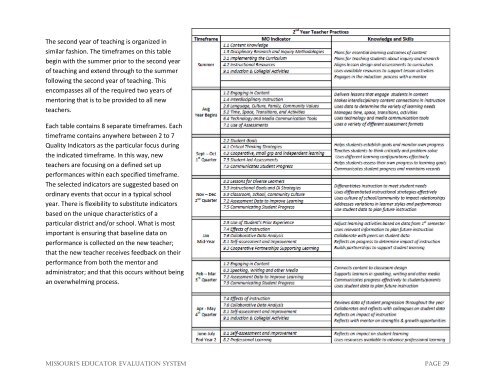eq-ees-teacher-evaluation
eq-ees-teacher-evaluation eq-ees-teacher-evaluation
The second year of teaching is organized in similar fashion. The timeframes on this table begin with the summer prior to the second year of teaching and extend through to the summer following the second year of teaching. This encompasses all of the required two years of mentoring that is to be provided to all new teachers. Each table contains 8 separate timeframes. Each timeframe contains anywhere between 2 to 7 Quality Indicators as the particular focus during the indicated timeframe. In this way, new teachers are focusing on a defined set up performances within each specified timeframe. The selected indicators are suggested based on ordinary events that occur in a typical school year. There is flexibility to substitute indicators based on the unique characteristics of a particular district and/or school. What is most important is ensuring that baseline data on performance is collected on the new teacher; that the new teacher receives feedback on their performance from both the mentor and administrator; and that this occurs without being an overwhelming process. Missouri's educator evaluation system Page 29
New Teacher Feedback and Evaluation Forms There are a series of new teacher feedback forms. These forms are aligned to the 8 timeframes that occur each year and collectively create the process for gathering baseline data on the new teacher’s performance. Each form specifically lists the quality indicators for the specified timeframe. Each indicator includes bulleted statements referencing the particular knowledge and/or skill to be demonstrated. There is opportunity to provide comments for each of the listed indicators. A 0 – 7 rating scale is also provided for each indicator. The rating scale and a full description of the performance it references are provided on each specific growth guide for each quality indicator. An overall determination on performance uses baseline and follow-up scores, feedback generated throughout the year on selected indicators, general feedback generated periodically through classroom observations and any other data or information relevant to the teacher’s performance observed or gathered throughout the year. This information is captured on feedback forms. This information and data is used to complete Summative Evaluation Form. Missouri's educator evaluation system Page 30
- Page 1 and 2: Teacher Evaluation Missouri’s Edu
- Page 3 and 4: Teacher Evaluation Protocol Introdu
- Page 5 and 6: principal, has identified Indicator
- Page 7 and 8: Alignment Of Evidence In this illus
- Page 9 and 10: learning goals based on their own r
- Page 11 and 12: Also provided is a document called
- Page 13 and 14: GOAL - Mrs. Johnson describes her g
- Page 15 and 16: Example On several occasions, Mrs.
- Page 17 and 18: Follow-up Score - 4 Growth Score -
- Page 19 and 20: The first 1 ½ pages of the summati
- Page 21 and 22: Example Mrs. Johnson’s administra
- Page 23 and 24: Step 7: Reflect and Plan Rationale
- Page 25 and 26: New Teacher Protocol The entry into
- Page 27: Baseline data, observed and gathere
- Page 31 and 32: Growth Opportunity - checking this
- Page 33 and 34: Growth Guide Missouri’s Educator
- Page 35 and 36: Teacher Growth Guide 1.1 Standard 1
- Page 37 and 38: Teacher Growth Guide 1.3 Standard 1
- Page 39 and 40: Teacher Growth Guide 1.5 Standard 1
- Page 41 and 42: Standard 2: Student Learning, Growt
- Page 43 and 44: Standard 2: Student Learning, Growt
- Page 45 and 46: Standard 2: Student Learning, Growt
- Page 47 and 48: Standard 2: Student Learning, Growt
- Page 49 and 50: Standard 3: Curriculum Implementati
- Page 51 and 52: Standard 3: Curriculum Implementati
- Page 53 and 54: Standard 4: Critical Thinking Teach
- Page 55 and 56: Standard 4: Critical Thinking Possi
- Page 57 and 58: Standard 5: Positive Classroom Envi
- Page 59 and 60: Standard 5: Positive Classroom Envi
- Page 61 and 62: Standard 6: Effective Communication
- Page 63 and 64: Standard 6: Effective Communication
- Page 65 and 66: Standard 7: Student Assessment and
- Page 67 and 68: Standard 7: Student Assessment and
- Page 69 and 70: Standard 7: Student Assessment and
- Page 71 and 72: Standard 7: Student Assessment and
- Page 73 and 74: Standard 8: Professionalism Quality
- Page 75 and 76: Standard 8: Professionalism Possibl
- Page 77 and 78: Standard 9: Professional Collaborat
The second year of teaching is organized in<br />
similar fashion. The timeframes on this table<br />
begin with the summer prior to the second year<br />
of teaching and extend through to the summer<br />
following the second year of teaching. This<br />
encompasses all of the r<strong>eq</strong>uired two years of<br />
mentoring that is to be provided to all new<br />
<strong>teacher</strong>s.<br />
Each table contains 8 separate timeframes. Each<br />
timeframe contains anywhere between 2 to 7<br />
Quality Indicators as the particular focus during<br />
the indicated timeframe. In this way, new<br />
<strong>teacher</strong>s are focusing on a defined set up<br />
performances within each specified timeframe.<br />
The selected indicators are suggested based on<br />
ordinary events that occur in a typical school<br />
year. There is flexibility to substitute indicators<br />
based on the unique characteristics of a<br />
particular district and/or school. What is most<br />
important is ensuring that baseline data on<br />
performance is collected on the new <strong>teacher</strong>;<br />
that the new <strong>teacher</strong> receives feedback on their<br />
performance from both the mentor and<br />
administrator; and that this occurs without being<br />
an overwhelming process.<br />
Missouri's educator <strong>evaluation</strong> system Page 29



